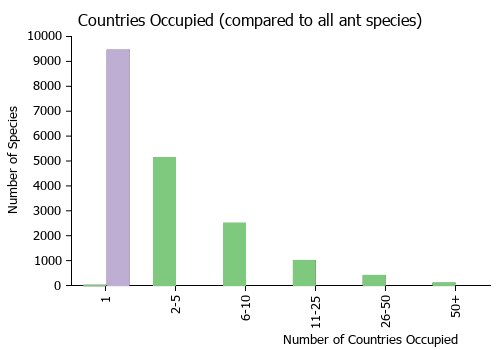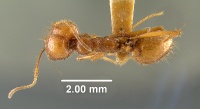Pheidole wallacei
| Pheidole wallacei | |
|---|---|

| |
| Scientific classification | |
| Kingdom: | Animalia |
| Phylum: | Arthropoda |
| Class: | Insecta |
| Order: | Hymenoptera |
| Family: | Formicidae |
| Subfamily: | Myrmicinae |
| Tribe: | Attini |
| Genus: | Pheidole |
| Species: | P. wallacei |
| Binomial name | |
| Pheidole wallacei Mann, 1916 | |
Nothing is known about the biology of wallacei.
Identification
See the description in the nomenclature section.
Keys including this Species
Distribution
Only known from the type locality.
Latitudinal Distribution Pattern
Latitudinal Range: 4.088888889° to 4.088888889°.
| North Temperate |
North Subtropical |
Tropical | South Subtropical |
South Temperate |
- Source: AntMaps
Distribution based on Regional Taxon Lists
Neotropical Region: Brazil (type locality).
Distribution based on AntMaps
Distribution based on AntWeb specimens
Check data from AntWeb
Countries Occupied
| Number of countries occupied by this species based on AntWiki Regional Taxon Lists. In general, fewer countries occupied indicates a narrower range, while more countries indicates a more widespread species. |

|
Estimated Abundance
| Relative abundance based on number of AntMaps records per species (this species within the purple bar). Fewer records (to the left) indicates a less abundant/encountered species while more records (to the right) indicates more abundant/encountered species. |

|
Biology
Castes
Nomenclature
The following information is derived from Barry Bolton's Online Catalogue of the Ants of the World.
- wallacei. Pheidole wallacei Mann, 1916: 437 (s.w.) BRAZIL. See also: Wilson, 2003: 362.
Unless otherwise noted the text for the remainder of this section is reported from the publication that includes the original description.
Description
From Wilson (2003): A large, relatively thin and long-legged member of the “jujuyensis complex” of the larger fallax group, comprising Pheidole araneoides, Pheidole chocoensis, Pheidole cuevasi, Pheidole jujuyensis, Pheidole kugleri, Pheidole leonina, Pheidole leptina, Pheidole lucretii, Pheidole lupus, Pheidole paraensis, Pheidole punctithorax, Pheidole tijucana, Pheidole wallacei and Pheidole wolfringi. P. wallacei is distinguished by the following combination of traits.
Major: scape surpasses antennal corner by about its own greatest width; carinulae reach midpoint of head capsule, and very small rugoreticular patches present laterad to circular carinulae of antennal fossae; humerus subangulate in dorsal-oblique view; propodeal spine small, equilateral in shape in side view.
Minor: occiput drawn out into a neck with a nuchal collar; body almost completely smooth and shiny; propodeal spine well-developed and relatively thin.
MEASUREMENTS (mm) Lectotype major: HW 1.74, HL 1.88, SL 1.60, EL 0.26, PW 0.96. Paralectotype minor: HW 0.74, HL 1.26, SL 2.04, EL 0.24, PW 0.58.
COLOR Major: concolorous reddish yellow.
Minor: concolorous medium yellow.
Figure. Upper: lectotype, major. Lower: paralectotype, minor. Scale bars = 1 mm.
Type Material
BRAZIL: Rio Madeira, Rondônia, col. William M. Mann. Museum of Comparative Zoology - as reported in Wilson (2003)
Etymology
Eponymous. (Wilson 2003)
References
- Wilson, E. O. 2003. Pheidole in the New World: A dominant, hyperdiverse ant genus. Harvard University Press, Cambridge, MA. (page 362, fig. major, minor described)
- Franco, W., Ladino, N., Delabie, J.H.C., Dejean, A., Orivel, J., Fichaux, M., Groc, S., Leponce, M., Feitosa, R.M. 2019. First checklist of the ants (Hymenoptera: Formicidae) of French Guiana. Zootaxa 4674, 509–543 (doi:10.11646/zootaxa.4674.5.2).
- Mann, W. M. 1916. The Stanford Expedition to Brazil, 1911, John C. Branner, Director. The ants of Brazil. Bulletin of the Museum of Comparative Zoology 60: 399-490 (page 437, soldier, worker described)
- Yamane, S., Tanaka, H.O., Hasimoto, Y., Ohashi, M., Meleng, P., Itioka, T. 2021. A list of ants from Lambir Hills National Park and its vicinity, with their biological information: Part II. Subfamilies Leptanillinae, Proceratiinae, Amblyoponinae, Ponerinae, Dorylinae, Dolichoderinae, Ectatomminae and Formicinae. Contributions from the Biological Laboratory, Kyoto University 31, 87–157.
References based on Global Ant Biodiversity Informatics
- Franco W., N. Ladino, J. H. C. Delabie, A. Dejean, J. Orivel, M. Fichaux, S. Groc, M. Leponce, and R. M. Feitosa. 2019. First checklist of the ants (Hymenoptera: Formicidae) of French Guiana. Zootaxa 4674(5): 509-543.
- Groc S., J. H. C. Delabie, F. Fernandez, M. Leponce, J. Orivel, R. Silvestre, Heraldo L. Vasconcelos, and A. Dejean. 2013. Leaf-litter ant communities (Hymenoptera: Formicidae) in a pristine Guianese rainforest: stable functional structure versus high species turnover. Myrmecological News 19: 43-51.
- Groc S., J. Orivel, A. Dejean, J. Martin, M. Etienne, B. Corbara, and J. H. C. Delabie. 2009. Baseline study of the leaf-litter ant fauna in a French Guianese forest. Insect Conservation and Diversity 2: 183-193.



